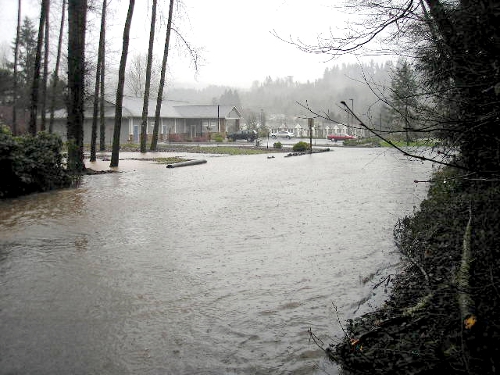STORMWATER: Problems and Solutions
Stormwater is rain and snow melt that runs off surfaces such as rooftops, paved streets, highways and parking lots. As stormwater runs off these surfaces, it picks up pollutants such as oil, fertilizers, pesticides, soil, trash and animal waste. This polluted stormwater is then discharged untreated into local water bodies such as the Cowlitz or Coweeman rivers. Managing stormwater is one of the most costly, challenging and complex environmental issues facing cities today.

N. 23rd Avenue near Allen Street, Kelso WA, January 2009
Originally, city stormwater systems were built to reduce flooding. Stormwater runoff was captured with storm drains and directed to local water bodies, or sometimes into sanitary sewer systems. More recently, it became clear that stormwater is the leading contributor to water quality pollution of urban waterways.
Untreated stormwater is unsafe as it contains toxic metals, organic compounds, bacteria, and viruses. These are unsafe for humans and they pollute streams providing habitat for fish and wildlife. Habitat loss from stormwater runoff is one of the primary obstacles to salmon recovery.
The challenge now is how to both prevent flooding and solve a major water quality problem. To do this many cities, including Kelso, have established a stormwater utility that charges their residents and businesses a fee based on the concept that every property contributes to stormwater runoff. Stormwater management programs involve planning, public education, illicit discharge detection programs, stormwater system maintenance and local ordinances to reduce stormwater pollution.
Many cities are currently implementing a newer approach to stormwater management known as Low-Impact Development (LID). Rather than directing stormwater offsite through drains and pipes, LID emphasizes the use of on-site natural features such as ponds, swales, or rain gardens that provide a place for rain to soak into the ground where it lands. Not only do these features reduce stormwater volume, they clean up the stormwater before it is discharged to groundwater or to the City’s stormwater system. For development and redevelopment projects in Kelso, LID is the preferred method to reduce stormwater quantity and to improve stormwater quality.








